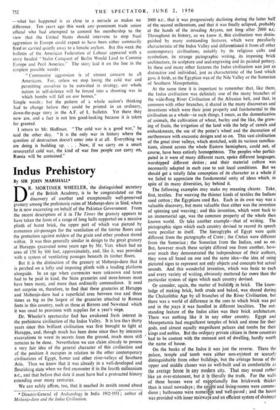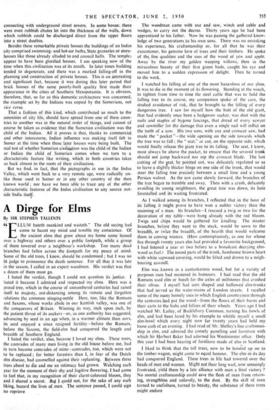Indus Prehistory
By SIR JOHN MARSHALL* DR. MORTIMER WHEELER, the distinguished secretary of the British Academy, is to be congratulated on the discovery of another and exceptionally well-preserved granary among the prehistoric ruins of Mohenjo-daro in Sind, where he is now excavating on behalf of the Pakistan Government. From the recent description of it in The Times the granary appears to have taken the form of a range of long halls supported on a massive plinth of burnt brick, the upper part of which was pierced by numerous air-passages for the ventilation of the timber floors and the protection against mildew of the grain and other produce stored within. It was thus generally similar in design to the great granary at Harappa excavated some years ago by Mr. Vats. which had an area of 150 by 100 feet, approximately, and, like it, was provided with a system of ventilating passages beneath its timber floors.
But it is the distinction of the granary at Mohenjo-daro that it is perched on a lofty and imposing plinth with a loading platform alongside. In an age when currencies were unknown and taxes had to be paid in kind, the State granaries and store-houses must have been many, and more than ordinarily commodious. It need not surprise us, therefore, to find that these granaries at Harappa and Mohenjo-daro had a superficial area between two and three times as big as the largest of the granaries attached to Roman forts in this country, such as those at Birrens and Newstead which it was usual to provision with supplies for a year's siege.
Dr. Wheeler's spectacular find has awakened fresh interest in the prehistoric civilisation of the Indus Valley. It is less than thirty years since this brilliant civilisation was first brought to light at Harappa, and, though much has been done since then by intensive excavations to wrest its secrets from the ground, much more still remains to be done. Nevertheless we can claim already to possess a very fair idea of the general character of this civilisation and of the position it occupies in relation to the other contemporary civilisations of Egypt, Sumer and other river-valleys of Southern Asia. Thus we know that it was already in a well-developed and flourishing state when we first encounter it in the fourth millennium ac., and that before that date it must have had a protracted history extending over many centuries.
We can•safely affirm, too, that it reached its zenith round about * Director-General of Archaeology in India 1902-1931 '4- ; author of Mohenjo-daro and the Indus Civilisation. 3000 B.C., that it was progressively declining during the latter half of the second millennium, and that it was finally eclipsed, probably at the hands of the invading Aryans, not long, after 2000 B.C. Throughout its history, as we know it, this civilisation was distin- guished by many outstanding features, which were peculiarly characteristic of the Indus Valley and differentiated it from all other contemporary civilisations, notably by its religious cults and symbolism, its strange pictographic writing, its imposing brick architecture, its sculpture and seal-engraving and its painted pottery. In these and many other features the Indus civilisation was just as distinctive and individual, just as characteristic of the land which gave it birth, as the Egyptian was of the Nile Valley or the Sumerian of Southern Mesopotamia.
At the same time it is important to remember that, like them, the Indus civilisation was definitely one of the many branches of the wide-flung River Civilisation of the Afrasian belt, and that, in common with other branches, it shared in the many discoveries and inventions which were their joint property and fundamental to the civilisation as a whole—in such things, I mean, as the domestication of animals, the cultivation of wheat, barley and the like, the grow- ing of fruits, the irrigation of the land' with the help of canals and embankments, the use of the potter's wheel and the decoration of earthenware with encaustic designs and so on. This vast civilisation of the great river valleys, which stretched, with its various ramifica- tions, almost across the whole Eastern hemisphere, could not, of course, have been entirely homdgeitkius. The peoples who partici- pated in it were of Many different races, spoke different languages, worshipped different deities ; and their material culture was necessarily adapted in each case to suit local conditions. But we should get a totally false conception of its character as a whole if we failed to appreciate the fundamental unity of ideas which, in spite of its many diversities, lay behind it.
The following examples may make my meaning clearer. Take, first, textiles. For weaving the thinner kinds of textiles the Indians used cotton ; the Egyptians used flax. Each in its own way was a valuable discovery, but more valuable than either was the invention of spinning and weaving ; and this invention, which went back to an immemorial age, was the common property of the whole then known world. Or take another example—that of writing. The pictographic signs which each country devised to record its speech were peculiar to itself. The hieroglyphs of Egypt were quite different from the pictographs of Crete ; the Cretan were different from the Sumerian ; the Sumerian from the Indian, and so on. But, however much these scripts differed one from another, how- ever much they demonstrated the independence of their authors, they were all based on one and the same idea—the idea of using pictured signs to represent not only objects and concepts but actual sounds. And this wonderful invention, which was basic to each and every variety of writing, obviously mattered far more than the particular system of signs which each country devised.
Or consider, again, the matter of buildifig in brick. The know- ledge of making brick, both crude and baked, was shared during the Chalcolithic Age by all branches of the River Civilisation, but there was a world of difference in the uses to which brick was put and in the ;ways it was handled in different localities. The out- standing feature of the Indus cities was their brick architecture. There was nothing like it in any other country. Egypt and Mesopotamia had magnificent temples of brick and stone for their gods, and almost equally magnificent palaces and tombs for their kings and nobles. But the ordigary private citizen in those countries had to be content with the meanest sort of dwelling, hardly worth the name of house.
On the banks of the Indus it was just the reverse. There the palace, temple and tomb were either non-existent or scarcely distinguishable from other buildings, but the average house of the upper and middle classes was as well-built and' as comfortable as the average house in any modern city. That may sound rather like an over-statement, but it is literally the truth. For the walls of these houses were of exceptionally fine brickwork thicker than is usual nowadays ; the certs` and living-rooms were commo- dious ; bathrooms were numer uS and well-paved ; and the house was provided with inner stairways and an efficient system of drainage
connecting with underground street sewers. In some house:, there were even rubbish chutes let into the thickness of the walls, down which rubbish could be discharged direct from the upper floors into a street dustbin.
Besides these remarkable private houses the buildings of an Indus city comprised swimming- and hot-air baths, State granaries or store- houses like those already alluded to and council halls. The temple; appear to have been glorified houses. I am speaking now of the time when this civilisation was at its zenith. In later times building tended to degenerate, and there was a marked falling-off in the planning and construction of private houses. This is an interesting and significant fact, because it was during this later period that brick houses of the same poorly-built quality first made their appearance in the cities of Southern Mesopotamia. It is obvious, therefore, that, so far as this domestic architecture was concerned, the example set by the Indians was copied by the Sumerians, not vice versa.
That a fashion of this kind, which contributed so much to the amenities of city life, should have spread from one of these coun- tries to another was in the natural order of things, and cannot of course be taken as evidence That the Sumerian civilisation was the child of the Indian. All it proves is that, thanks to commercial and other intercourse, Indian influence was making itself felt in Sumer at the time when these later houses were being built. The real test of whether Sumerian civiI0,tion was the child of the Indian or Indian the child .of, Sumerian comes when we tern to A characteristic feature like writing, which in both countries takes us back almost to the roots of their civilisation.
But we find, in fact, that the pictographs in use in the 4ndus Valley, which went back to a very remote age, were radically un- like those used in Sumer or in any other country of the then known world ; nor have we been able to trace any of the other characteristic features of the Indus civilisation to any source out- side India itself.



































 Previous page
Previous page